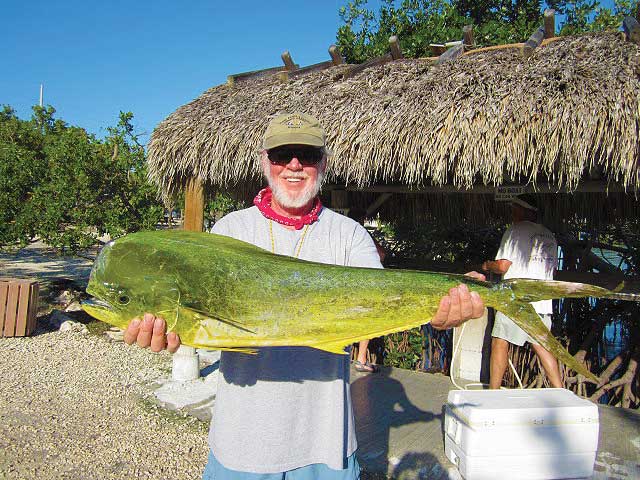Photo courtesy of Big Pine Key Fishing Lodge
By Cam Staff
They call Islamorada the Sportfishing Capital of the World. This slim string of six small islands about halfway down the Florida Keys separates the Atlantic from the Gulf of Mexico, and just offshore in the Atlantic, warm blue currents of the Gulf Stream deliver a steady flow of baitfish and the big migrating pelagic species that feed on them.
The Continental Shelf is a highway for swordfish that move through in depths of 1,400 to 1,900 feet with a consistency that may be unmatched anywhere in the world. It is possible to target these deepwater giants any month of the year off Islamorada, and even during the day. But it is sportfishing only for hardcore anglers. Swordfish are elusive anywhere, the most difficult of the billfish to catch, and fights lasting several hours are the reward for tempting a bite from 150- to 400-pound or larger fish deep in the abyss. If catching a swordfish is one of the boxes that remains to be checked off on your bucket list, you’d be hard pressed to find a better place to do it.
A little closer in, where the Gulf Stream swings over broken bottom and the offshore humps Islamorada has become famous for, it creates rips where disoriented baitfish become easy prey for dolphin, wahoo, sailfish, kingfish and tuna. In the summer months, flocks of birds are a dead giveaway for dolphinfish pushing frenzied bait to the surface. When that’s not going on, fish can be found trolling feather or jet head lures and plugs. A bite while trolling means it’s time to slow down and cast baits to catch other fish drawn to the same area. Sometimes this is met with spectacular results, especially for mahi, which tend to gather in numbers.
Some of the most spectacular action on the humps comes from blackfin tuna. It can show up in spurts any time of year, but fall typically brings a push of 10-pound-plus tuna that can be incited into surface-feeding frenzies. Chumming up blackfins with pilchards is a very visual experience that allows even anglers armed with fly rods to hook up with multiple hard-fighting fish. As the tuna move toward the reefs with the late fall and winter baitfish migrations, the bigger fish begin to show up, and kite fishing becomes one of the preferred methods for teasing up fish 20 pounds and larger.
The other fish that shows up to take advantage of baitfish from November through the winter is sailfish. There’s a reason why Islamorada is home to so many sailfish tournaments during the winter months. It can seem like everyone drops everything they’re doing for a chance to fly release flags.
In fall and winter, sails move in to gorge on abundant ballyhoo around the reefs. This can present opportunities to anglers less than 5 miles from the docks off the islands of Islamorada. The 130- to 200-foot depths produce the most consistent bite where strong currents and changes in water color to a deep royal blue give away the edges and rips where sailfish hunt. Trolling or kite fishing the reefs can produce numerous fish in the 60-pound range when the bite is on.
But on sunny days when the weather cooperates, it is possible to sight fish for sailfish inside the reefs in water as shallow as 20 or 30 feet. Even smaller boats can get in on this action. From the tower, crewmembers seek out the fish. When the alarm goes out, chum and baits are deployed. There’s really no technique more exciting. Anglers in the know await those bluebird skies on winter days when seeking out sailfish becomes as much hunting as it is fishing.
And if all the offshore action isn’t enough to convince any angler to start making plans right now, fall also brings some of the biggest bonefish of the year to the Islamorada flats. Time it right, and you can be fishing the flats in the morning and trolling the bluewater in the afternoon. What more could you ask for?
[easy-social-share]
